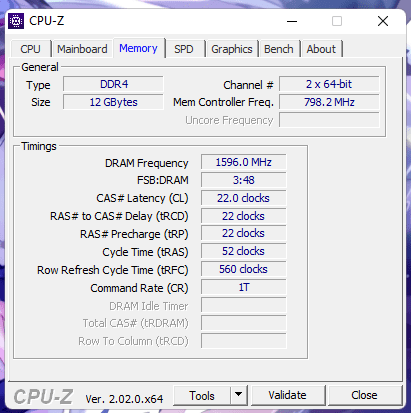Comparing: DDR4 3200MHz SODIMM vs LPDDR5 4800MHz
In this comparison, we analyze two Memory: DDR4 3200MHz SODIMM and LPDDR5 4800MHz, using synthetic benchmark tests to evaluate their overall performance. This side-by-side comparison helps users understand which hardware delivers better value, speed, and efficiency based on standardized testing. Whether you're building a new system or upgrading an existing one, this benchmark-driven evaluation offers valuable insights to guide your decision.

DDR4 3200MHz SODIMM
| Type: | Memory |
|---|---|
| Model: | DDR4 3200MHz SODIMM |
| Freq: | 3200MHz |
Specification Comparison Table
This specification comparison presents technical details of several devices or components to help you understand the key differences between each option. Use this table as a reference to determine which device best suits your needs.
| Specification | DDR4 3200MHz SODIMM | LPDDR5 4800MHz |
|---|---|---|
| Model | DDR4 3200MHz SODIMM | LPDDR5 4800MHz |
| Frequency | 3200MHz | 4800 MHz |
Submission Comparison Table
This submission comparison table displays the number and details of benchmark data submissions from various devices or components. This information helps you understand the performance based on the benchmarks that have been tested, as well as providing an overview of the consistency and popularity of the available benchmark results.
| No. | Benchmark Software | DDR4 3200MHz SODIMM | LPDDR5 4800MHz |
|---|---|---|---|
| 1 | PYPrime - 2B with BenchMate |
16sec, 394ms |
14sec, 377ms |
| 2 | AIDA64 - Memory Read |
42265 points |
49727 points |
Submission Comparison Chart
This chart visualizes the benchmark scores comparison between two hardware devices based on submitted data.
Media Gallery
A collection of photos of tested hardware. These images can help you identify the physical form, model, and variant of the hardware in question. These photos are from our own documentation, and if they are not available we may not be able to document them.
About Hardware DDR4 3200MHz SODIMM
DDR4 3200MHz SODIMMs are the latest generation of memory modules designed to deliver high speed, better power efficiency and responsive multitasking performance on modern laptop devices. In this test, the RAM configuration consisted of 8GB V-GeN DDR4 3200MHz SODIMM and 4GB DDR4 3200MHz soldered on-board (unknown brand), resulting in a total capacity of 12GB in dual channel mode, significantly increasing memory bandwidth and overall system performance.
The test was conducted using a Lenovo IdeaPad Slim 3i 14ITL6 laptop, powered by an Intel Core i5-1135G7 processor, NVIDIA MX350 graphics, and Windows 11 Home operating system. This configuration represents mid-range usage commonly found on daily productivity laptops, whether for office, multimedia, or light editing.
The V-GeN DDR4 3200MHz SODIMM module comes with a timing configuration of 22-22-22-52-1T, which although not in the low-latency category for the high-performance class, is still capable of providing optimal stability and efficiency in daily use. When tested using the PYPrime 2B benchmark application via BenchMate, the memory managed to complete a large calculation in just 16 seconds and 394 milliseconds, reflecting the good coordination between the memory and processor in handling heavy computing workloads. In addition, testing using AIDA64 Memory Read showed a score of 42,265 points, indicating a high data read speed. These results also reinforce the effectiveness of the system's dual channel configuration, where the combination of one 8GB module and one 4GB module proved to significantly optimize memory bandwidth in handling both large data transfer processes and heavy multitasking.
DDR4 at 3200MHz is now a common standard in new laptops due to its ability to handle modern applications and multitasking operating systems such as Windows 11. The combination of 12GB capacity and high frequency makes this configuration ideal for users looking to increase productivity without having to replace their entire system, simply by adding or combining a single piece of quality SODIMM RAM such as from V-GeN.
For users who require speed of response, power efficiency and multitasking capabilities, DDR4 3200MHz SODIMM is a great choice. Its wide availability and high compatibility with both Intel and AMD processors make it highly versatile for a variety of purposes, from students, professionals, to casual gamers.
Device test (testbed):
Device: Lenovo IdeaPad Slim 3i 14ITL6
Specs: i5-1135G7, NVIDIA MX350, 12GB RAM 3200MHz (4+8), 512GB NVMe SSD, Windows 11 Home
Friday, 06 August 2021 05:58:27 | Update: 1 month ago
About Hardware LPDDR5 4800MHz
The 4800MHz LPDDR5 module embedded in the Acer Aspire 5 A515-58P is a next-generation memory solution specifically designed to deliver high speed and maximum power efficiency in modern devices such as ultrabooks and thin laptops. It uses Micron-made chips with a total capacity of 8GB embedded directly into the motherboard (onboard), making it non-upgradable yet more space and energy efficient than conventional SODIMM modules. Running at a frequency of 4800MT/s and timings of CL52-44-44-104 1T, this LPDDR5 offers extremely low latency and much higher memory bandwidth compared to previous generations such as LPDDR4X.
In performance testing, this memory showed very impressive results for the thin laptop class. In the PYPrime 2B benchmark with BenchMate, the time recorded was only 14 seconds 377 milliseconds, indicating a very solid CPU and RAM performance in processing heavy computing loads based on integer calculations. Meanwhile, testing using AIDA64 Memory Read showed a reading of 49,727 points, proving that Micron's 4800MHz LPDDR5 is capable of delivering high memory read speeds, which greatly supports the smooth multitasking, productivity and media consumption needs of the Windows 11 22H2 operating system.
With its combination of high power efficiency, excellent data transfer speed, and direct device integration, LPDDR5 4800MHz is the ideal choice for modern laptop users who prioritize responsiveness and battery life without compromising on performance.
Device test (testbed):
Device: Acer Aspire 5 A515-58P
CPU: i5 1335U
RAM: 8GB LPDDR5 (Fix, Cannot Upgrade)
OS: Windows 11 22H2
Tuesday, 15 August 2023 13:16:48 | Update: 1 month ago


